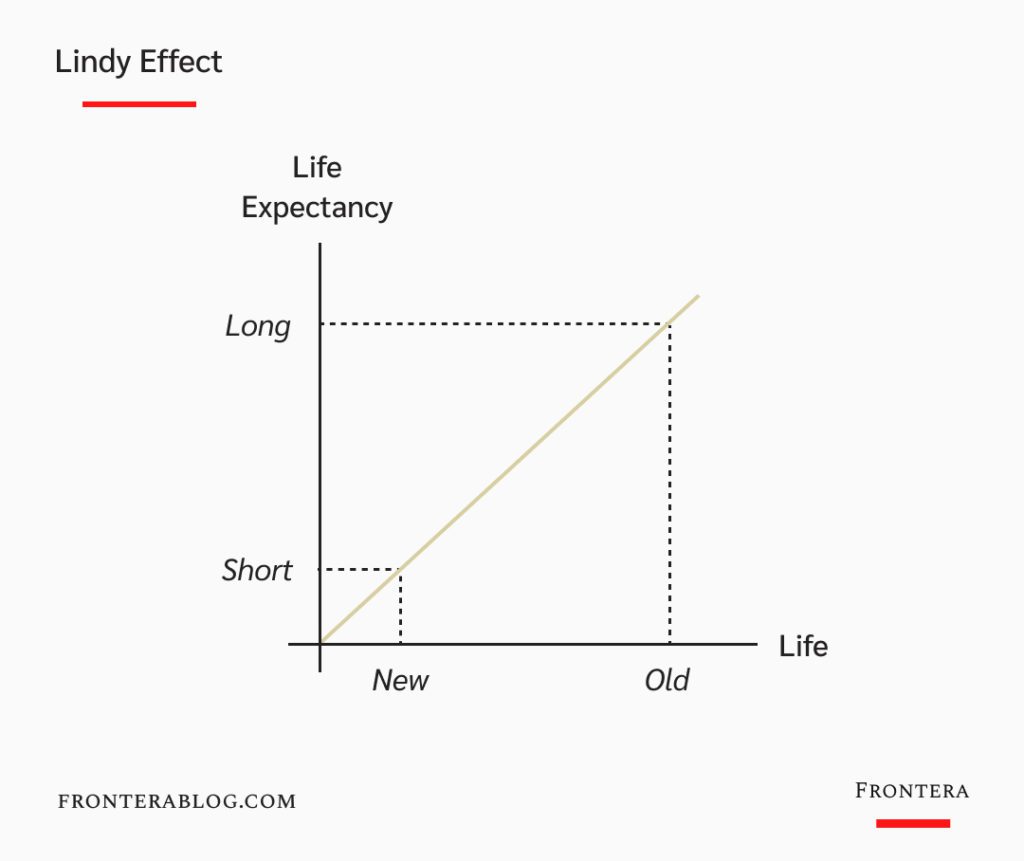What is the Lindy Effect?
According to the Lindy Effect, the older an idea, a technology or a company gets, the longer it will live in the future. It’s aging in reverse. And it’s a useful mental model to understand the world better.
Imagine you are in a library.
You see hundreds of books one next to the other. Different covers, different writers, different genres.
They all store ideas in them.
How can you know if the idea you’ll get from a book will be valid in 5, 20, or 50 years?
Let’s see.
As we (humans) get older, we have less time to live. But ideas don’t have a lifespan.
So when you see a book from Plato, Sun Tzu, or Marcus Aurelius in the library; you can be sure the ideas are time-tested.
They have profound wisdom, which made them live through millenniums. And they are likely to be around thousands of years in the future.
That means the life expectancy of ideas increases as they get older.

Where does the name “Lindy” come from?
The Lindy Effect’s name has an interesting story.
In 1964, people who worked in show business often went to the Lindy Restaurant on Broadway.
And discussed business there.
Writer Albert Goldman was one of the regulars of the Lindy Restaurant.
And he wrote an article called “Lindy’s Law” to explain how the chances of a new comedian surviving on TV increase each year:
“The life expectancy of a television comedian is inversely proportional to the total amount of his exposure on the medium. If, pathetically deluded by hubris, he undertakes a regular weekly or even monthly program, his chances of survival beyond the first season are slight; but if he adopts the conservation of resources policy favored by these senescent philosophers of “the Business”, and confines himself to “specials” and “guest shots”, he may last to the age of Ed Wynn.”
Perishable vs. Non-Perishable
The Lindy Effect didn’t immediately become popular as a concept after Goldman’s article.
It took almost half a century.
Nassim Taleb built on Goldman’s idea in his book Antifragile.
First, he separated perishable and nonperishable:
“Let us separate the perishable (humans, single items) from the nonperishable, the potentially perennial. The nonperishable is anything that does not have an organic unavoidable expiration date. The perishable is typically an object, the nonperishable has an informational nature to it. A single car is perishable, but the automobile as a technology has survived about a century (and we will speculate should survive another one). Humans die, but their genes—a code—do not necessarily. The physical book is perishable—say, a specific copy of the Old Testament—but its contents are not, as they can be expressed into another physical book.”
And after this separation, gives a clear definition of the Lindy Effect:
“For the perishable, every additional day in its life translates into a shorter additional life expectancy. For the nonperishable, every additional day may imply a longer life expectancy.”
Let’s see some examples.
The Lindy Effect Examples:
1. Money
Lydians thought they could use coins as a store of value. So everybody could buy goods with money instead of bartering.
And the idea of money has been around for thousands of years since then. So according to the Lindy effect, we can expect money to be around for at least thousands of years in the future.
On the other hand, Bitcoin is only 15 years old. If we apply Lindy, we can expect it to be around 15 more years.
And every year it lives will add more to its life expectancy.
2. Companies
New startups have a high failure rate. But each year they survive, they increase their chances to survive longer and become a successful company.
It means they faced a crisis, management changes, competition, and expansion and survived.
So in the future, they are more likely to overcome new challenges than a younger company.
In a way, the Lindy effect proves the antifragility of the company.
3. Life
Let’s stretch the theory a bit and apply it to our personal lives.
- The longer you’ve been friends with somebody, the longer your friendship will be in the future.
- The longer you work in a company, the longer you are likely to stay there in your career.
- The longer you keep a habit (positive or negative), the longer you will have it in the future.
- The longer you procrastinate on something, the longer you will in the upcoming months.
Now, I said stretching theory because all these have a limit —our lifespan— as we are perishable.
But it’s eye-opening, isn’t it?
How To Use Lindy Effect In Business
Trends come and go.
But some things never change.
Like human behavior.
So master what won’t change in the future.
And you’ll gain an unfair advantage over others.
Jeff Bezos explained this perfectly in an interview about Amazon’s initial success:
“I very frequently get the question: ‘What’s going to change in the next 10 years?’
And that is an interesting question. It’s a very common one.
But I almost never get the question: ‘What’s not going to change in the next 10 years?’
And the second question is actually the more important of the two — because you can build a business strategy around the things that are stable in time.
In our retail business, we know that customers want low prices, and I know that’s going to be true 10 years from now.
They want fast delivery; they want a vast selection.
It’s impossible to imagine a future 10 years from now where a customer comes up and says, ‘Jeff I love Amazon; I just wish the prices were a little higher,’ or ‘I love Amazon; I just wish you’d deliver a little more slowly.’
Impossible.
And so the effort we put into those things, spinning those things up, we know the energy we put into it today will still be paying off dividends for our customers 10 years from now. When you have something that you know is true, even over the long term, you can afford to put a lot of energy into it.”
–
Enjoyed this article?
Then you’ll love the How Brands Win Newsletter.
Get the “5 Mental Models to Differentiate Your Business” guide when you join. It’s free.
References:
Article: “We may be trained to think that the new is about to overcome the old, but that’s just an optical illusion. Because the failure rate of the new is much, much higher than the failure rate of the old.” Nassim Taleb’s article on Wired from 2012.
Article: A lawyer shapes his life based on Lindy Effect: The Lindy Way of Living
Book: Nassim Taleb, Antifragile.
